Jun 6, 2014 | celebration, commemorative, commentary, foreign, history
Operation Overlord was the largest amphibious invasion in history.
Originally scheduled on May 1, it was rescheduled to June 5 and then June 6 because of weather.
Commanded by Gen. Dwight D. Eisenhower, the invading force consisted of 156,000 Allied troops using 5,000 ships and landing craft bringing on shore 50,000 vehicles with overhead support from 11,000 planes and 13,000 paratroopers.
Across 50 miles of Normandy coast line, the United States forces were assigned Utah and Omaha beaches, the British Army was assigned to Gold and Sword beaches, and the Canadian Army invaded Juno beach.
Operation Bodyguard created six decoy invasions as a distraction to the Germans so as to divert their attention from the intended invasion at Normandy. Gen. George S. Patton, considered the most skillful tank commander in U.S. military history, commanded a fake mission to invade Pas-De-Calais.
Omaha Beach was the focus of the attack because it was the most heavily defended beach.
On the first day, 4,414 Allied soldiers were confirmed dead.
Victory was declared on July 21, 1944 when the Allied forces captured Caen, one of the major objectives of the invasion.
The Normandy American Cemetery in Colleville-Sur-Mer is the final resting place for 9,387 Americans. Across its 172.5 acres sits 9,238 crosses and 149 Stars of David where 41 sets of brothers and 3 Medal of Honor recipients rest. The Walls of the Missing is engraved with the names of 1,557 soldiers missing in action.
On this, the 70th Anniversary of D-Day, the day Operation Overlord began, there is one more statistic that should not exist:
The number of commemorative coins issued by the United States to honor those that served and gave their lives to help begin the liberation of Europe from the worst criminal of all time: ZERO!
Although the U.S. Mint did issue a World War II 50th Anniversary commemorative coin in 1995, this country should honor those who participated in the largest amphibious invasion in history and set the world on a safer course.
With the number of veterans of that day dwindling as they are all nonagenarians, I would like to thank them for their service and the families of the fallen for their service. I only wish that congress would realize that their bickering over nonsense with flags on their lapels pales in comparison to the sacrifices made on that day in France. They just do not get it.
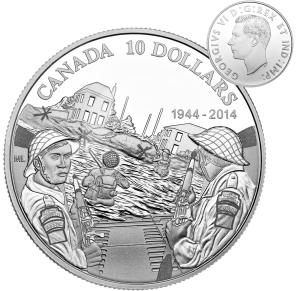
Canadian $10 Commemorative of the 70th Anniversary of D-Day featuring the obverse portrait of King George VI, the reigning monarch at the time of the invasion.
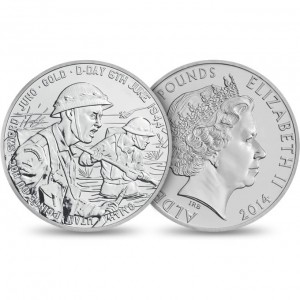
70th Anniversary of D-Day 2014 Alderney £5 BU Coin from the Royal Mint.
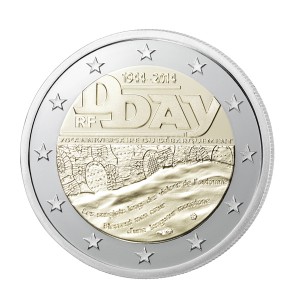
Bimetallic 2 € commemorative issue from the Monnaie de Paris (Paris Mint)
Jun 4, 2014 | coins, commemorative, legislative, policy, US Mint
S. 2303: United States Coast Guard Commemorative Coin Act
Sponsor: Sen. Christopher Murphy (D-CT)
• To require the Secretary of the Treasury to mint coins in commemoration of the United States Coast Guard
• Introduced: May 7, 2014
• Referred to the Senate Committee on Banking, Housing, and Urban Affairs
Track this bill at https://www.govtrack.us/congress/bills/113/s2303
S. 2310: Mother’s Day Commemorative Coin Act
Sponsor: Sen. John “Jay” Rockefeller IV (D-WV)
• To require the Secretary of the Treasury to mint coins in commemoration of Mother’s Day
• Introduced: May 8, 2014
• Referred to the Senate Committee on Banking, Housing, and Urban Affairs
Track this bill at https://www.govtrack.us/congress/bills/113/s2310
Note that the likelihood of these bills passing is slim-to-none and Slim just left town. Since Sen. Rockefeller is retiring after this session, there is a small chance that Mother’s Day commemorative could be voted on by unanimous consent in December as a legislative “going away present.”
May 5, 2014 | coins, commemorative, legislative, policy, US Mint
Our long national nightmare is over, congress finally passed some sort of numismatic-related legislation. But do not get too excited because today’s news out of the House of Representatives is only the beginning. Next is for the Senate to do nothing while the bill languishes in committee.
H.R. 627: National Park Service 100th Anniversary Commemorative Coin Act
Sponsor: Rep. Erik Paulsen (R-MN)
• To provide for the issuance of coins to commemorate the 100th anniversary of the establishment of the National Park Service.
• Passed the House of Representatives: April 29, 2014
• Received in the Senate on April 29, 2014 and referred to the Senate Committee on Banking, Housing, and Urban Affairs
Track this bill at https://www.govtrack.us/congress/bills/113/hr627
Apr 10, 2014 | coins, commemorative, commentary, legislative, policy, US Mint
 Amongst all of the noise on Capitol Hill, the one area where no noise has been made is in the numismatic arena. For the last three months there has been no bill introduced, heard in committee, or acted on by either chamber of congress. Although there have been some hearings on a few issues, the last numismatic-related bill that had any congressional action was the introduction of the Pro Football Hall of Fame Commemorative Coin Act, S. 1842, introduced by Sen. Rob Portman (R-OH) in December.
Amongst all of the noise on Capitol Hill, the one area where no noise has been made is in the numismatic arena. For the last three months there has been no bill introduced, heard in committee, or acted on by either chamber of congress. Although there have been some hearings on a few issues, the last numismatic-related bill that had any congressional action was the introduction of the Pro Football Hall of Fame Commemorative Coin Act, S. 1842, introduced by Sen. Rob Portman (R-OH) in December.
This type of inactivity is unusual for congress. Regardless of party, congress is always looking to curry favor with their constituents and groups associated with their constituents by introducing commemorative coin legislation. Over the last few congresses (a two-year term), there will be over 40 coin-related bills that die in committee where very few even get a cursory hearing.
This does not mean there will be no commemorative coins in the near future. Now, the U.S. Mint has issued the Civil Rights Act of 1964 Silver Dollar and National Baseball Hall of Fame commemoratives. In fact, the Baseball Hall of Fame coins are so popular that the gold option has sold out of its 50,000 statutory mintage limit.
As an aside, a friend pointed out that the U.S. Mint did not bring 50,000 gold coins to the Whitman Baltimore Expo and wondered how many of those coins were purchased by baseball’s owners and members of the Baseball Hall of Fame. It would be interesting to see the effect of organized baseball on the sale of these coins.
In 2015, the U.S. Mint is scheduled to release a March of Dimes Commemorative Silver Dollar commemorative coin. Founded in 1938 by President Franklin D. Roosevelt to combat polio, the March of Dimes changed its mission to combating birth defects after the discovery of the polio vaccine by Dr. Jonas Salk in 1954. Salk’s work was supported by the organization.
Also on the schedule for 2015 is the United States Marshals Service 225th Anniversary commemorative coin series. The Marshal Service commemoratives will include a gold $5, silver dollar, and clad half-dollar coins. I do not think this will be as popular as the 2005 Marine Corps 30th Anniversary commemorative coins.
Officially, the 2016 scheduled commemorative will be the Mark Twain Commemorative coin program that will only include gold $5 and silver dollar coins. However, considering Twain’s mindset about being famous, I think he would be amused by having a commemorative coin made in his honor. I might call it the “Mark Twain Amusement commemorative.”
The only other commemorative coin with legislation that has passed congress and signed by the president is the 2017 Lions Clubs International Century of Service Silver Dollar.
Given the law says that there will be no more than two commemorative coin series per year (31 U.S.C. §5112(m)); and given that the next time only one commemorative coin is scheduled to be issues is in 2016, there is plenty of time for congress to do “something” and pass one of the bills that is currently waiting for their action.
Apr 5, 2014 | Baltimore, coins, commemorative, gold, silver, US Mint, video
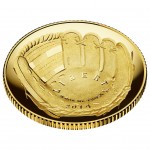
2014 National Baseball Hall of Fame Commemorative Proof $5 gold coin obverse
It has been speculated that the U.S. Mint will strike more coins than the law (Public Law 108–291 [PDF]) allows on order from the Secretary of the Treasury. No official decision has been announced by either the U.S. Mint or the Department of the Treasury. However, it is questioned whether it is legal for the Secretary to make this decision unilaterally or requires an act of congress. There seems to be evidence that someone had previously approved an increase for the 2005 Marine Corps Commemorative dollar, but there is no authoritative source for proof.
Collectors who have contacted me are not happy with the U.S. Mint. Many believe that the high limit (50 coins per “household”) was too high. When I posted images of the graded baseball coins, several commented that they felt that dealers “abused” their access to the immediate supply of coins that were available in the U.S. Mint booth at the Whitman Baltimore Expo that many collectors did not have a fair chance.
None of my correspondents would bemoan a dealer’s ability to make money on the secondary market. But to do so by taking advantage of the U.S. Mint’s inability to manage its market as the lone producer of U.S. commemorative coins was considered excessive by many. Although I sympathized with their point of view since I could not purchase one for my collection, I questioned whether the U.S. Mint has an obligation to just sell the coins or satisfy market forces. But as many pointed out, the U.S. Mint is a government agency and has a responsibility to the people of the United States and not just the corporations.
While at the Whitman show I spoke with one of the U.S. Mint employees who said that they should have limited the number of coins someone can purchase at one time. Although they did enforce lower limits on the supply of coins sold on Saturday, the damage had been done leaving collectors to scramble to buy the coins on the secondary market or order them online. Those of us who order the coins from the U.S. Mint online catalog will have to wait until June 21, according to the notice sent to me. However, the website is saying that the proof dollar is backordered until July 7 while the clad proof half-dollar is will be available on April 10.
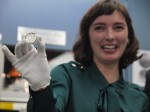
Cassie McFarland holds up Baseball Hall of Fame Commemorative Dollar with her design
We are talking about baseball, America’s pastime. America’s game. Regardless of the accepted story of its founding, it is generally accepted that Major League Baseball was founded in 1869 making it the oldest organized league in North America. Not only was the coin released just before Opening Day for 2014, but the National Baseball Hall of Fame and Major League Baseball have been promoting this coin since the bill was signed.
To even hint that this was going to be a situation like the failure of the 2013 Girl Scout Commemorative would be very short sighted and foolish.
Maybe the U.S. Mint should review its sales processes than chase after pattern coins.
In the mean time, the U.S. Mint published a B-Roll for the National Baseball Hall of Fame Commemorative.
Coin image and B-Roll footage courtesy of the U.S. Mint.
Image of Cassie McFarland courtesy of the
San Francisco Examiner.
Mar 30, 2014 | Baltimore, coins, commemorative
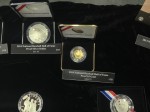
Display of the National Baseball Hall of Fame Commemorative Coins at the U.S. Mint booth
With news coverage that covered almost every media outlet because of its unique curved design, the U.S. Mint invited Baltimore Orioles Hall of Famer Brooks Robinson to their booth at the Baltimore Convention Center on Thursday, March 27. Nothing gets the attention of the local Baltimore market more than bringing in a popular former Orioles player. Only Cal Ripkin, Jr. would have given them more attention and probably an even bigger draw.
By early Friday afternoon, when I was able to arrive to the show, the U.S. Mint was sold out of all options, including the uncirculated coins. With the plant manager of the Philadelphia mint present, he was able to order more coins to be delivered to the convention center for Saturday. But you had to be there early in order to purchase one of these coins. If you had to work and was not able to arrive to the convention center until later in the afternoon, like I did, you were out of luck.
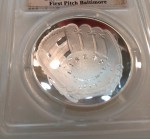
2014 National Baseball Hall of Fame commemorative proof dollar graded by PCGS PR70
Resigned to the fact that the U.S. Mint once again failed to meet market demand, I ordered a proof dollar and half-dollar online. I also made sure my order was for more than $75 so that I can get one of the U.S. Mint reusable bags. I can use the bag to transport items to and from my coin club meetings.
The fact of the matter is that after last year’s failure of the Girl Scout commemorative coin to sell the minimum necessary for the Girl Scouts to benefit, it looks like the National Baseball Hall of Fame commemorative may be a home run. What would be a grand slam is that there were rumors on the bourse floor that the U.S. Mint was going to ask congress to update the law so that they can produce more coins. In the current law (Public Law 112–152 [PDF]), the U.S. Mint is limited to producing 50,000 $5 gold coins, 400,000 $1 silver coins, and 750,000 half-dollar clad coins.
If congress raises the mintage limits for the National Baseball Hall of Fame commemorative, it may be the first time they do so for any commemorative coin. Based on a search of online records with the Government Printing Office, there is no record of a modern commemorative coin (since 1982) having its mintage limits increase.
A sellout of these commemoratives would be good for the National Baseball Hall of Fame and Museum. According to the law, the National Baseball Hall of Fame would receive $35 for each gold coin sold, $10 for each silver dollar, and $5 for each half-dollar. If there is a sellout, the Hall of Fame stands to make $9.5 million. That would buy them over 63,000 dozen baseballs, 950,000 Louisville Sluggers made from ash, or more than 12,000 baseball fields using FieldTurf with some money left over for maintenance. Now that’s a lot of baseball!
Jan 3, 2014 | coin design, coins, commemorative, commentary, COTY
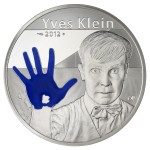
Monnaie de Paris 2012 Yves Klein commemorative was named 2014 Coin of the Year

2011 Commemorative celebrating the 100th anniversary of the Royal Dutch Mint’s facilities with QR code on reverse
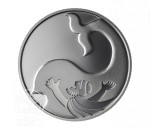
2010 Jonah In The Whale 2-New Sheqalim coin from Israel

2009 White Rhinoceros 100 Rand gold coin from South Africa
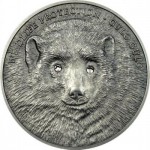
2008 Mongolia Wolverine with diamonds for eyes
Three of the last five COTY winners had design elements that were not based on the sculpture of the coin but on a design gimmick. Were these the best designs or did the gimmick influence the voting?
I have asked before whether it is wrong to include other design elements on a coin, especially non-circulating legal tender (NCLT) coins. When I ask these questions, I bring out the picture of my Somalia motorcycle or muscle car coins. I also like the Canadian 2006 Breast Cancer silver commemorative coin and the special 25-cent circulating coin the Royal Canadian Mint produced. These were not overt uses of color but almost an enhancement to emphasize the pink ribbons on the coins.
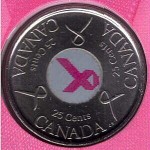
2006 Breast Cancer Quarter was Canada’s first colored circulating coin
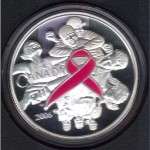
2006 Breast Cancer Silver Coin with colored pink ribbon.
But is it too much of a gimmick? After the RCM produced those coins it seems that they dove in face first into producing colored coins. It also seems that the rest of the world also has been spending its time printing coins and not minting them (see the New Zealand Mint). Although I am guilty of buying into this type of design concept, there comes a time when the concept has gone too far. In television the concept is called “Jumping the Shark.”
While others are printing coins, the Royal Mint is coming up with designs that are interesting sculptures. In fact, if you go to their website and look at their offerings you will find that the Royal Mint has nice designs, interesting packaging, but no color. Although their artists take advantage of the design elements using bi-metallic coins, they are sculptured arts and not printed designs.
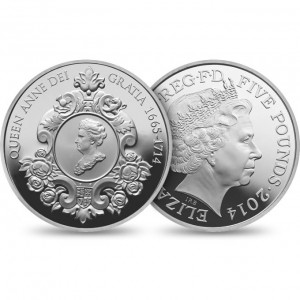
2014 £5 crown commemorating the 300th anniversary of the death of Queen Anne
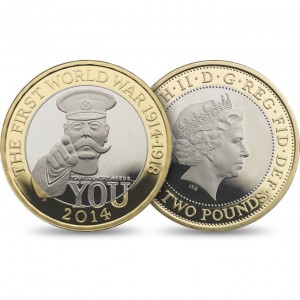
2014 £2 coin commemorating the 100 year anniversary of the start of World War I
U.S. coin designs have had the best designs over the last few years. However, the introduction of the “enhanced uncirculated” coins with the selective frosting has opened up new ways of enhancing sculpture elements on coins. It would be interesting to see what the U.S. Mint artists can do if given the free hand to design coins and using the laser to enhance the design.
Given the recent history of the COTY competition, the 2014 National Baseball Hall of Fame commemorative coin is almost a shoo-in for 2016 COTY honors. While the elements will be sculpted rather than printed and the curved planchet will be interesting, it is probably enough of a gimmick to sway the World Coin News confab when it meets to discuss the 2014 coin in December 2015.
As an aside, why do we have to wait a year for the COTY competition? With technology what it is today, why does it take a year to do the COTY competition? If the award is given in February, then why select the COTY in December or January? Does it really make sense for the 2014 COTY to be coins date 2012? Why not call it the 2012 COTY since the coins are dated 2012 and award them at the beginning of 2013—or in this case, the 2013 COTY being awarded in 2014?
The one year delay might have made sense when mail delivery was less reliable and information was delayed by the speed of the teletype and the printing press. In the information age where 2012 is not only yesterday’s news it is ancient history, it is time for Krause Publications and World Coin News to modernize their process and come up with something a little quicker than a one year delay.
Image Credits
- 2012 Yves Klein commemorative courtesy of the Monnaie de Paris.
- 2011 Royal Dutch Mint commemorative with QR code courtesy of the Royal Dutch Mint.
- 2010 Jonah in the Whale commemorative courtesy of the Israel Coins & Medals Corp.
- 2009 White Rhinoceros 100 Rand gold coin courtesy of Krause Publications.
- 2008 Mongolia Wolverine coin courtesy of the Wolverine Foundation.
- 2014 British coin images courtesy of the Royal Mint.
Jan 1, 2014 | celebration, coins, commemorative
Happy New Year!
As we begin a new year, we should look forward to better times for our hobby, our nation, and our world. I wish you and yours a Happy and Healthy 2014 and hope that you find the key coin of your dreams!
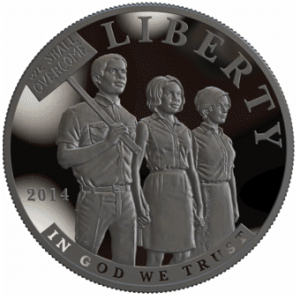
2014 Civil Rights Act of 1964 Silver Dollar obverse
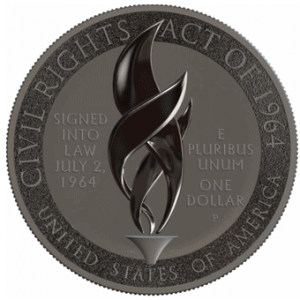
2014 Civil Rights Act of 1964 Silver Dollar reverse
Images courtesy of the U.S. Mint.
Dec 31, 2013 | coin design, coins, commemorative, US Mint
For the first time ever, the U.S. Mint will be producing a coin that is not flat. The curved coin is of the 2014 National Baseball Hall of Fame Commemorative Coin.
The National Baseball Hall of Fame Commemorative Coin Act (Public Law 112-152 [PDF]) celebrates the 75th Anniversary of the National Baseball Hall of Fame in Cooperstown, New York. The three-coin commemorative program consisting of a $5 gold coin (50,000 maximum mintage), $1 silver coin (400,000 maximum), and a clad half-dollar (750,000 maximum) struck as uncirculated coins or as proofs.
The bill required an open competition for a common obverse design “emblematic of the game of baseball.” During the government shutdown this past October, the U.S. Mint posted the announcement on their website that the winning design was submitted by Cassie McFarland of San Luis Obispo, California.
McFarland told reporters that she stumbled upon the competition while researching coins for another art project. McFarland found the U.S. Mint’s call for design two days before the deadline and submitted a drawing. Her drawing was based on an old baseball glove belonging to a relative.

Cassie McFarland
U.S. Mint Sculptor-Engraver Don Everhart will do the engraving of McFarland’s winning design. Everhart created the reverse design.
Surcharges will be $35 per gold coin, $10 per silver coin, and $5 for the clad half-dollar to be paid to the National Baseball Hall of Fame for their continuing operations. If all the coins sell out, the Hall of Fame will receive $9.5 million for ongoing operations.
Given that the selection of Coin of the Year tends to favor gimmicks (to explained in a future post), it would not be surprising that this coin wins COTY when it is considered at the end of 2015.
In the mean time, it will be interesting to see this coin in hand as this is the #1 numismatic-related story as selected by the board of the Coin Collectors Blog!
Curved coin animation courtesy of the U.S. Mint.
Nov 25, 2013 | bullion, coins, commemorative, Eagles, poll, US Mint
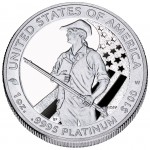
2012 American Eagle Platinum Proof reverse “To Provide for the Common Defence”
Let’s pretend that the Citizens Coinage Advisory Committee could bypass congress (very wishful thinking!), Citizens Coinage Advisory Committee, and the U.S. Commission of Fine Arts to build a portfolio of non-circulating legal tender commemoratives to increase collector sales. Today’s poll, which will run for two weeks, asks what the U.S. Mint should do with its pretend freedom.

Loading ...
For the record, I am in favor of allowing the U.S. Mint to increase the offerings under the American Eagle program. The U.S. Mint has done some of that to this point with the enhanced reverse uncirculated coins and special sets. There should be more special offerings or different offerings. The U.S. Mint could change the reverse designs to honor different themes like they have been doing on the reverse of the platinum American Eagle coins.
I would also like to see more of the enhanced uncirculated American Silver Eagle coins. The way it enhanced Adolph Weinman’s Walking Liberty design makes it a great looking collectible.





















